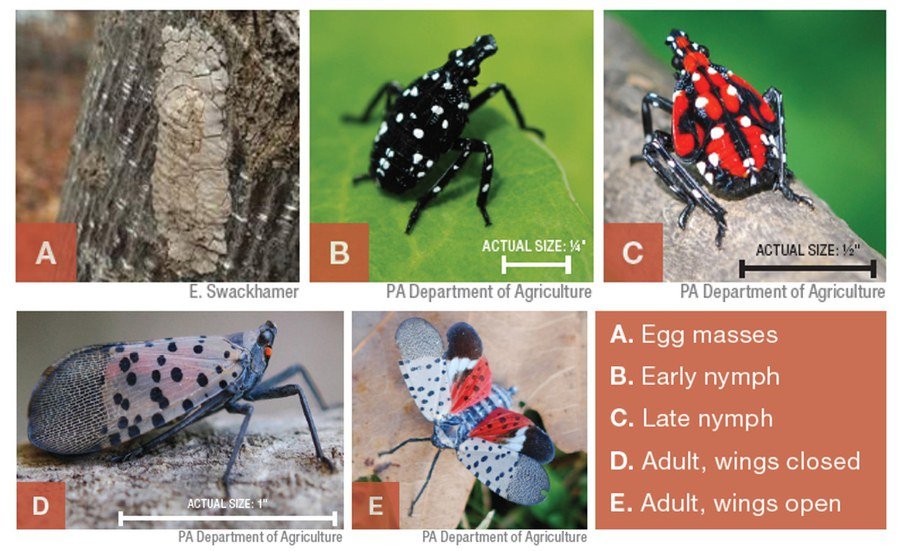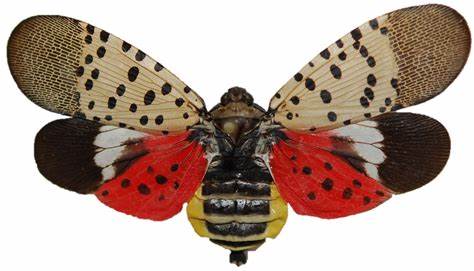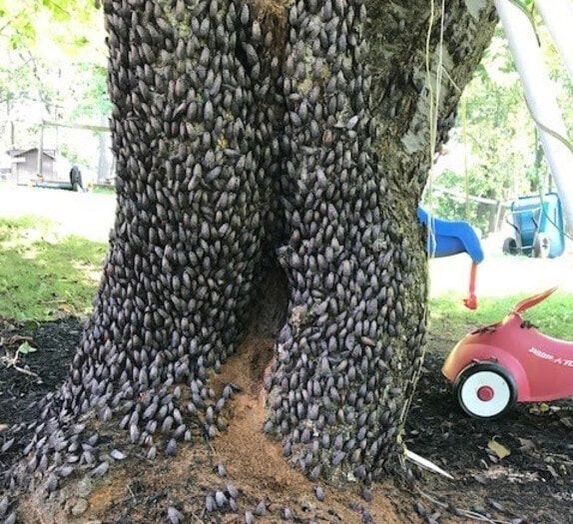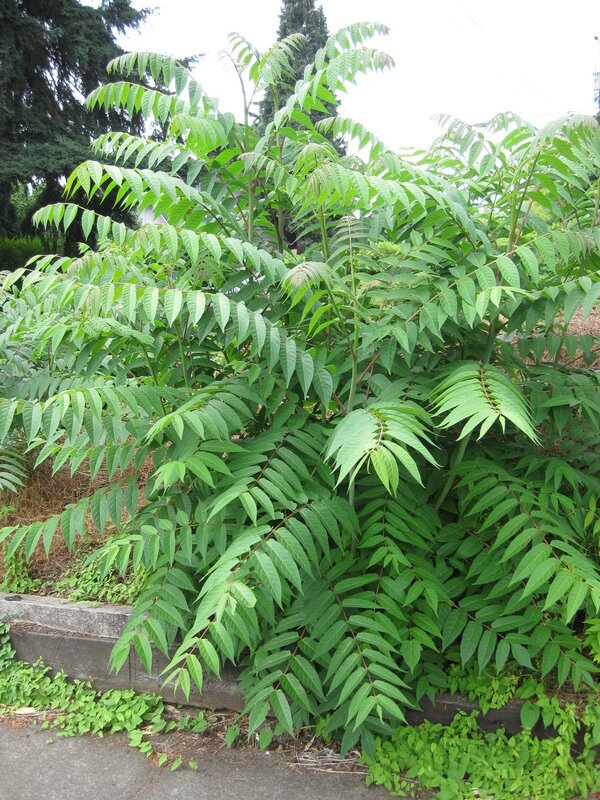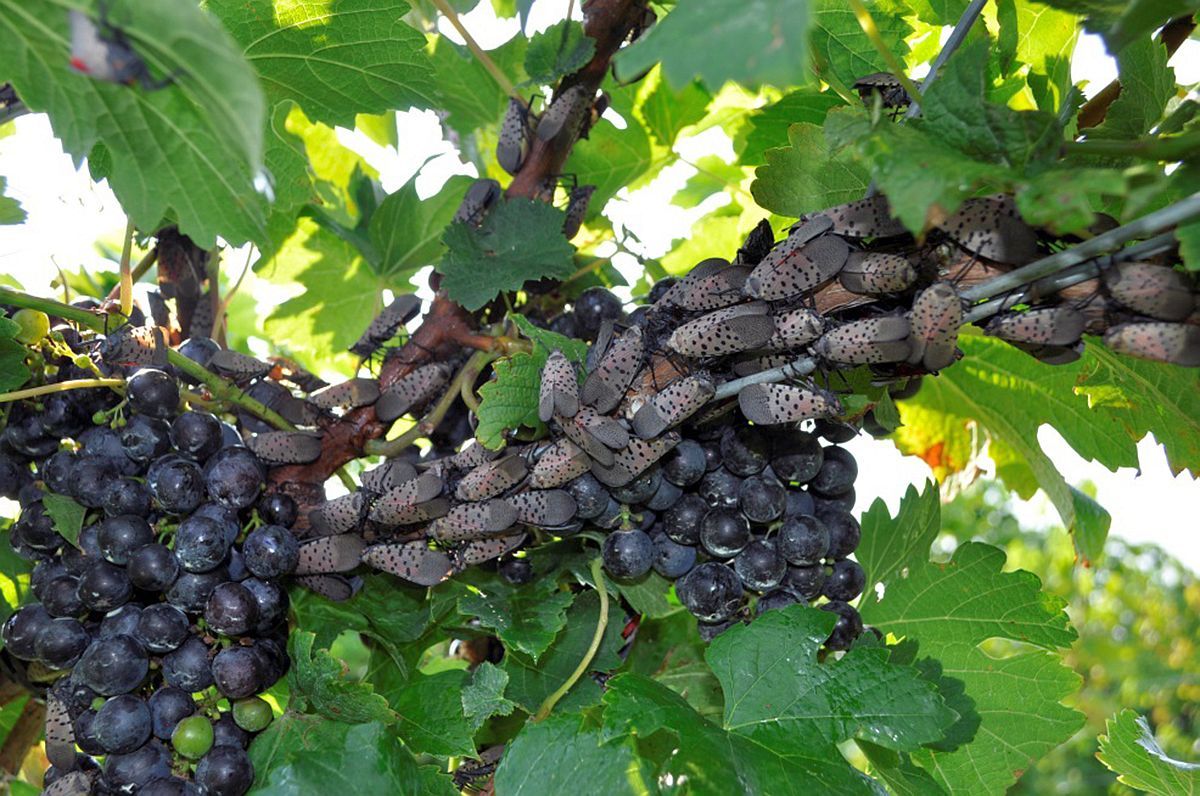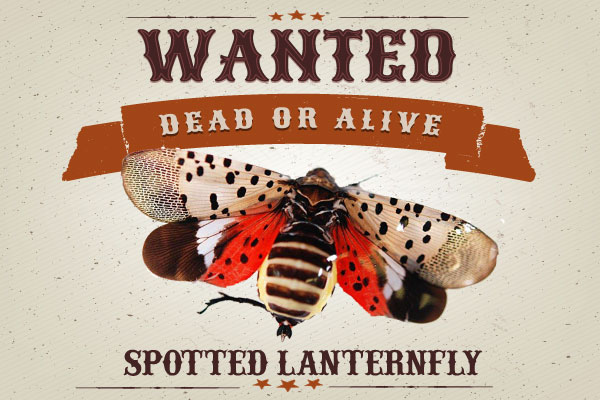SPOTTED LANTERNFLYSpotted lanternfly (SLF), Lycorma delicatula, is an invasive planthopper, native to Asia, that was first detected in 2014 in southeastern Pennsylvania. It feeds voraciously on many plants, including economically important crops like fruit trees, grapevines, hops, hardwoods, and ornamentals. If you think you have SLF, do not panic! First, make sure the insect you are seeing is the spotted lanternfly. Second, learn about its life cycle and habits. Third, determine what plants it is infesting and what it is not. Fourth, employ management strategies at the proper time of the year.
There is one generation of SLF per year. The eggs are laid in the fall and hatch in the spring. Egg masses are laid on hard surfaces (trees, decks, houses, outdoor equipment, rocks, etc.) and protected with a mud-like covering. Each egg mass contains 30–50 eggs. After hatching and before reaching adulthood, SLF goes through four nymph stages. Nymphs are small (⅛ to ½ inch) and can be hard to find. The first three stages (instars) are all black with white spots, and the last instar is red with white dots and black stripes (Figure 1). SLF adults emerge in July and are active until winter. This is the most obvious and easily detectable stage because they are large (~1 inch) and highly mobile. Adults have black bodies with brightly colored wings. Only the adults can fly. Because SLF adults jump more than fly, their wings often remain closed. SLF wings are gray with black spots, and the tips of the wings are black with gray veins. When you travel in and out of the quarantine zone, check your car and outdoor equipment (grills, outdoor furniture, landscaping supplies, mowers, etc.). Check for SLF egg masses from late fall to early spring. Remember that egg masses may be underneath your car or in your wheel well. During all other times of the year, check for nymphs and adults, and keep your windows rolled up when you park. Don’t store things or park under infested trees, and don’t move firewood. Steps of Spotted Lanternfly Management
Walk around your property to check for egg masses on trees, cement blocks, rocks, and any other hard surface. If you find egg masses on your property from September to May, you can scrape them off using a plastic card or putty knife (Figure 3). Scrape them into a bag or container filled with rubbing alcohol or hand sanitizer and keep them in this solution permanently. Egg masses can also be smashed or burned. Remember that some eggs will be laid at the tops of trees and may not be possible to reach. Tree Banding When the nymphs first hatch, they will walk up the trees to feed on the softer new growth of the plant. Take advantage of this behavior by wrapping tree trunks in sticky tape and trapping the nymphs. Any tree can be banded, but we recommend only banding trees where SLF are abundant (Figure 4). Tape may be purchased online or from your local garden center. Push pins can be used to secure the band. While some bands may catch adults, banding trees is most effective for nymphs. Be advised that birds and small mammals stuck to the tape, while rare, have been reported. To avoid this, you can cage your sticky bands in wire or fencing material wrapped around the tree. Alternately, try reducing the width of the band, so that less surface area is exposed to birds and other mammals. Both of these methods will still capture SLF effectively. Check and change traps at least every other week (or more often in highly infested areas). Host Removal Tree-of-heaven (Ailanthus altissima) is an invasive plant, but it is common in landscape plantings and disturbed areas, such as along the sides of roads.This is the preferred host for SLF, and current management efforts are focused on removing this tree. Apply herbicide to the tree from July to September and wait at least 30 days before removing the tree. Failure to apply herbicide will result in new growth from the stump; even when treated, multiple applications may be necessary over time to completely kill the tree. These trees can get very tall, so seek the help of a tree care service if necessary. Tree-of-heaven is named because of its rapid growth; it can reach up to 100 feet tall and 6 feet in diameter. The bark of tree-of-heaven is similar to the outside of a cantaloupe. When crushed, the leaves put off a foul odor that many describe as rotten peanut butter. They spread by seed and will also produce “clones” by their roots. This tree can be mistaken for other native species, including black walnut, hickory, and staghorn sumac. For help identifying and treating this plant, visit the Penn State Extension spotted lanternfly website. While tree-of-heaven is a preferred host, SLF feeds on a large variety of plants, including many of the trees in your backyard. Removing these may not be preferred; refer to the next section for further guidance. Chemical Control Only use insecticides that are registered by the Environmental Protection Agency (EPA) to treat any insect on your property. All EPA-registered insecticides have an EPA registration number and a label for appropriate and legal use. Home remedies should not be used against spotted lanternfly because they may be unsafe to humans, pets, and plants and could be illegal. Insecticides can kill insect pests on contact and/or by being present systemically in a plant that the insect pests eat. The duration of control that remains after application (i.e., residual activity) varies depending on which type of insecticide is used. Contact insecticides kill SLF when the chemical contacts the insect as a direct spray or when the insect walks over a surface with insecticide residue on it. Systemic insecticides are absorbed by tree roots, bark, or leaves and are moved through its vascular system to other parts of the tree. When systemic insecticides are used, SLF is killed as it feeds on any part of the tree, even if it was not sprayed directly (e.g., spraying the lower part of the tree will protect the tree tops). Systemic insecticides work best when applied from July-September. However, systemics can also be applied at other times of year, depending on the application method. For example, a soil drench should be applied earlier in the summer. There are four main methods to apply insecticides: tree injection (applied by professional applicators), bark sprays, soil drenches, and direct sprays (can be applied by homeowners). The Pennsylvania Department of Agriculture and the U.S. Department of Agriculture are currently using the systemic insecticide dinotefuran as bark sprays on tree-of-heaven to kill SLF. Systemic insecticides can work well and have residual activity that lasts from several weeks to several months. Property owners should consider hiring a certified pesticide applicator to make insecticide applications. Professional applicators have specialized training and equipment to treat trees. Hiring a professional may reduce your risk of pesticide exposure and save time, but it may cost more than doing the application yourself. |
An SLF quarantine is currently in effect for 14 counties in Pennsylvania. If you find a spotted lanternfly, kill it and report it immediately with the online reporting system or by calling 1-888-4BAD-FLY (1-888-422-3359). The image below shows the different lye stages of the SLF, for more information go to https://extension.psu.edu/spotted-lanternfly or go to www.agriculture.pa.gov
|
|
Bradford County Conservation District
Stoll Natural Resource Center 200 Lake Road, Suite E | Towanda PA 18848 Phone: (570)-485-3144 |


